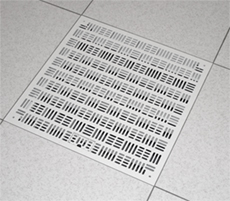Ian Seaton, CPI’s Technology Marketing Manager, recently received the following question.
Question: What floor tile perforation pattern (percentage open) do you recommend in data centers using cabinets with Vertical Exhaust Ducts?
 Answer: If your data center uses CPI cabinets with Vertical Exhaust Ducts (VED) such at the F-Series TeraFrame Cabinet or the T-Series SteelFrame Cabinet, it ultimately does not matter where the air comes from or how it gets into the data center. However, since we have not addressed this particular subject before, your question represents an opportunity to talk further on the subject.
Answer: If your data center uses CPI cabinets with Vertical Exhaust Ducts (VED) such at the F-Series TeraFrame Cabinet or the T-Series SteelFrame Cabinet, it ultimately does not matter where the air comes from or how it gets into the data center. However, since we have not addressed this particular subject before, your question represents an opportunity to talk further on the subject.
We recommend using one style of perforated tile through-out the space. Varying tile styles creates a mind-set for micro-managing the tile deployment, which is completely unnecessary in a VED data center. In fact, the concern is that a great concentration on micro-managing insignificant details could result in over-looking the only macro variable of any consequence – assuring there is enough total air volume delivered into the space to maintain a slight positive pressure.
We do not recommend baffled floor tiles for both the above micro-managing concern as well as the very real danger of baffles being closed during room/network maintenance activities and not re-opened. All of us who spend time auditing user sites have seen this happen.
 In general, it is safe to say that for lower densities it is appropriate to use 25% open tiles and for higher densities it would be appropriate to use 56% open grates. However, it is not a simple matter to determine where that line should be drawn. The chart below provides some guidelines on how much heat might be dissipated per floor tile, based on the static pressure under the raised floor. If the static pressure is therefore known or, more importantly manageable, then these relationships would indicate what type of tiles would be required to deliver enough air into the room to dissipate a particular heat load if there were a 1:1 relationship between server cabinets and perforated floor tiles. Furthermore, that ratio of perforated floor tiles to cabinet can be increased for higher heat loads. However, more perforated floor tiles do not magically produce free extra air – an air source must adjust to maintain the associated and requisite static pressure.
In general, it is safe to say that for lower densities it is appropriate to use 25% open tiles and for higher densities it would be appropriate to use 56% open grates. However, it is not a simple matter to determine where that line should be drawn. The chart below provides some guidelines on how much heat might be dissipated per floor tile, based on the static pressure under the raised floor. If the static pressure is therefore known or, more importantly manageable, then these relationships would indicate what type of tiles would be required to deliver enough air into the room to dissipate a particular heat load if there were a 1:1 relationship between server cabinets and perforated floor tiles. Furthermore, that ratio of perforated floor tiles to cabinet can be increased for higher heat loads. However, more perforated floor tiles do not magically produce free extra air – an air source must adjust to maintain the associated and requisite static pressure.
kW Cooling per Cabinet per Floor Tile |
Static |
1-2 U Server |
Blade Server |
Pressure |
25% |
56% |
25% |
56% |
.01" H2O |
1.5kW |
3.9kW |
2.6kW |
6.8kW |
.025" H2O |
2.5kW |
6.2kW |
4.4kW |
10.8kW |
.05" H2O |
3.6kW |
9.1kW |
6.2kW |
15.9kW |
.075" H2O |
4.4kW |
11.3kW |
7.6kW |
19.8kW |
.1" H2O |
5.1kW |
12.5klW |
8.9kW |
21.9kW |
|
|
|
|
|
Published flow specs for Tate brand tiles using
90 CFM per kW for blades and 155 CFM for 1-2 U servers
Finally, In a VED data center where all bypass leaks are sealed off and the raised floor joints themselves have less than 0.1% leakage, then significantly higher under floor static pressure levels can be achieved for greater flow per tile, thereby reducing the tile count requirement for high densities.
In conclusion, therefore, while the type of floor tile is important in standard hot aisle – cold aisle data centers, it is really much less critical in a VED data center than assuring there is enough total airflow and sufficient sealing between the supply and return air masses to maintain a positive pressure in the supply mass of the room. If you have comments or questions about this article, please leave a comment or call us at 800-834-4969. Ian Seaton, Technology Marketing Manager